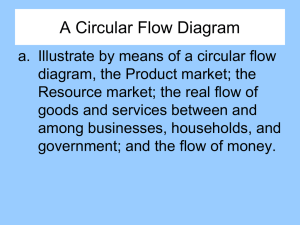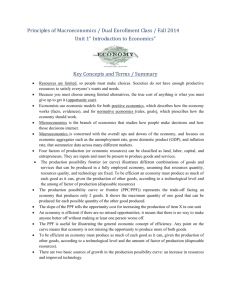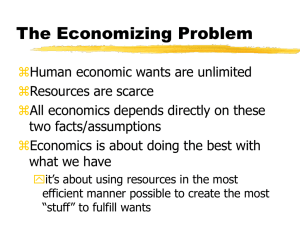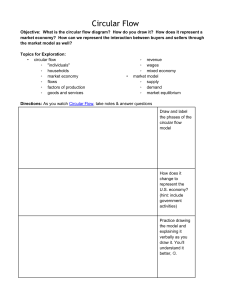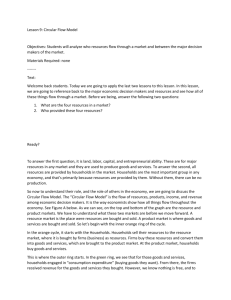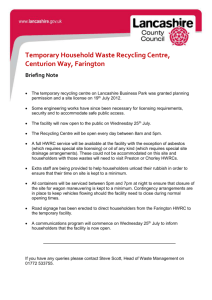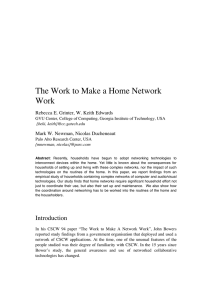Ch 2 Economizing Problem
advertisement
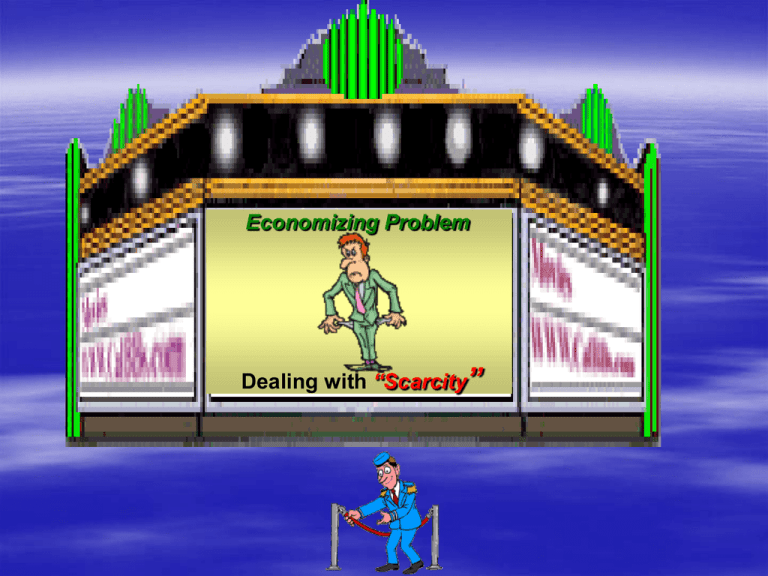
Economizing Problem
Dealing with “Scarcity”
Scarcity - When There Is Not Enough
For Everyone – Someone Suffers
THE FOUNDATION OF ECONOMICS
SOCIETY HAS VIRTUALLY UNLIMITED WANTS...
THE FOUNDATION OF ECONOMICS
SOCIETY HAS VIRTUALLY UNLIMITED
WANTS...
BUT LIMITED OR SCARCE RESOURCES!
GOODS & SERVICES PROVIDE...
UTILITY [satisfaction]
GOODS & SERVICES PROVIDE...
UTILITY[satisfaction]
LUXURIES
Luxuries
.
V.
NECESSITIES
Food
Clothing
Shelter
The Four Factors of Production
Resources beget production, which. beget income, which beget wealth.
1. Land [natural resources] – Nature’s items [“gifts of nature”]
A. In the earth - coal, oil, water, fossil fuels, etc.
B. On the earth – vegetation and water
C. In the atmosphere – sun, wind, and rain
[Land is the starting point of all production.”
“Stuff” from which everything is made.
Water
Wind
Sun
Fossil fuels
“Gifts of Nature”
2. Labor [human resources] {“effort”}
anyone who works [“paid work”]
[Labor is the “brain-power” and
“muscle-power” of human beings]
A. Physical – pro basketball players & lumberjacks
B. Intellectual – ministers, doctors & lawyers
*Most important resource -70% of input cost
“Hired Help”
3. Capital Resources – all “man-made inputs” used to produce
consumer products (machinery, physical plants, & tools).
A. Capital goods – goods [machinery, buildings, & tools] used to
produce other goods. [crane, Ford plant, hammer]
[products meant for “future consumption”]
B. Consumer goods – products meant for “immediate consumption”.
“Real Capital” [machinery, physical plants & tools] [capital is a
factor of production] v. “Financial Capital” [stocks, bonds, & $] [not factors of production]
A product can be both a consumer good & a capital good –depends on its use.
Ex: Jet aircraft used by a movie star to visit friends (consumer good). The same
aircraft used by a business manager to serve customers [capital good].
Ex: F150 pick-up to deliver produce [capital good] or take family to church [consumer good]
“man-made inputs”
Rent
Land
Wages
Labor
Interest
Capital
Profits
Entrepreneur
4. Entrepreneurship – starting a new business or introducing a new
product. “Sparkplugs” who introduce the product or start the new
business. He combines land, labor, & capital to produce products.
Resource payments. The resource owners receive rent [for
the use of their land; wages [for their labor]; interest [payment
for financial capital], and profits [for their entrepreneurial ability].
Real Capital v. Financial Capital
.
Notes...
INVESTMENT
REAL CAPITAL
[tools, machinery, & factories]
Can produce something
directly with these
FINANCIAL CAPITAL
Can’t produce anything
directly with these
[stocks, bonds, & money]
RESOURCE
PAYMENTS
Property Resources
LAND
CAPITAL
RENTAL INCOME
INTEREST INCOME
HUMAN RESOURCES
LABOR
ENTREPRENEUR
WAGES
PROFIT & LOSS
The Opportunity Cost is the Opportunity Lost
Opportunity Set
Oportunity Benefit
[“what is possible”]
Opportunity Cost
Scarcity
Choices
Opportunity Costs
Trade-offs–decision (choice) to get more of
one thing means to accept less of another.
Opportunity Cost – 2nd Choice
(most important concept in economics)
[what you sacrifice when you make a choice]
“I’m in love with
both, but can
have only one.”
Krisily
Sarah B
The Bachelor
Charlie O’Connell
And – As 40 Million Watched,
Joe Millionaire chose Zora over Sarah
Economic Way of Thinking
Do the Benefits outweigh the cost?
Scales of Economics
Expected marginal benefits
Expected marginal costs
Choices are primarily marginal – not all or nothing.
A look at one of the
tallest of the High 5
support structures
High Five will cost $261 million
Non-economic
Way Of Thinking
2 mil. Lbs
of concrete,
200,000 lbs
There is one more
highway project and
nothing less of
anything else.
of reinforcing
Economic
steel Way
Will be completed 1-1-07.
Will earn $32,000 per day
for each day before 1-1-07.
It will cost $80,000 per day
for each day past 1-1-07.
Cost twice as much as any
There is one more
highway project &
a lot less of many
other things.
other state transport. project.
500,000 cars daily
300 workers on site
Of Thinking
Opportunity Cost
Better Job
Of Doing Your Best In School
You always do
your homework
Better chance
in college
Better chance at
the best colleges
Cheerleaders doing flips
to get your attention
Better chance
to be the boss
Beautiful
Spouse
Always get
a prom date
Learn
Responsibility
Better Grades
mean fewer
problems at home
Report Card
Better
Self-esteem
A Econ
A English
A Calculus
A Journalism
C Sex Ed
Opportunity Cost
[of NOT doing your best]
[Poor self-esteem]
He will have a difficult path
More problems at home
“No, I will not go to
the prom with you.
You are a loser.”
You don’t do your best
Opportunity Cost
[of NOT doing your best in school]
Worse Job
“Paper or Plastic?”
“Do You want fries
with that?”
And finally – the real opportunity cost of a bad
education is that you have to drive a ?
YUGO
Only way to get up a hill
Which would begin to rust while still in the show room,
Would shake when it hit 35 mph,
Would break in half going over RR tracks,
And would never be stolen even if you left the
keys in it with the motor running.
The Yugo on the inside or under the hood
Anytime you filled the Yugo with gas,
you doubled its value.
Putting seats in tripled its value.]
Budget Line
Number of hamburgers & pizzas that can be bought for $30.
Limits of Production
Constant Opportunity Cost
1 Bus=4 Cars; ¼ Bus=1 Car
6
Movies
5
Constant Opportunity Cost
1 T-shirt = 2 movies;
½ T-shirt = 1 movie
4
3 Opportunity
Cost
2
Opportunity
1
Benefit
0
1
T-shirts
2
3
• http://www.reffonomics.com/productionpossib
ilitiescurve3.html
PRODUCTION POSSIBILITIES
Two Examples of Economic Growth
Goods for the Future
FAVORING PRESENT GOODS
CURRENT
CURVE
CONSUMPTION
Goods for the Present
PRODUCTION POSSIBILITIES
Two Examples of Economic Growth
CURRENT
CURVE
FUTURE
CURVE
CONSUMPTION
Goods for the Present
FAVORING
FUTURE GOODS
Goods for the Future
Goods for the Future
FAVORING
PRESENT GOODS
CONSUMPTION
FUTURE
CURVE
CURRENT
CURVE
Goods for the Present
Going to War (U.S.) When
the U.S. entered WWII, we had severe unemployment.
We were able to step up production of consumer goods and war materials simply by
getting to full production. We went from 14.6% unemployment in 1940 to 1.2% in 1944.
Over 7 million people went to work that were not working in 1940.
United States
C
War Goods
[Beginning of WWII]
F
Civilian Goods
Going to War(Russia). Russia, on the other hand, entered WWII at full capacity.
So their preparedness entailed a shifting of resources from civilian goods and a drop in
their standard of living.
The U.S. position was similar as we entered the Viet Nam War at full employment.
We increased both military spending and domestic spending on the “War on
Poverty.” Our attempt to achieve more “guns and butter” in a FE economy was
doomed. We were trying to spend beyond capacity and ended up with double
digit inflation in the 1970s.
C
Russia
War Goods
D
Civilian Goods
[Beginning of WWII]
C
A
P
I
T
A
L
G
O
O
D
S
AB
G
C
D
F
E
Consumer Goods
40. At what letter is there unemployment [recession]? F
41. What letters represent resources being used in their
most productive manner? [full employment, full
production, and best available technology] A,B,C,D,E
42. What letter represents an improvement in technology,
therefore a new PPC frontier line?
G
43. The (straight line/curve) illustrates the “line of increasing cost”?
44. The (straight line/curve) illustrates the “law of constant cost.”
45. At what letter would there be the most economic growth in
the future if a country were producing there now? A
46. What is the opportunity cost when moving from “C” to “D”; Capital
Consumer E to B; & do we have to give anything up when moving from F to D?no
PPC Practice Questions
1. An economy that is fully employing all its productive
resources but allocating less to investment than
to consumption will be at which of the following
positions on the PPC to the right?
a. A
b. B
c. C
d. D
e. E
2. Which of the following best explains the shape of the
PPC for the two-commodity economy shown above?
a. Opportunity cost of producing another unit of each stays the same.
b. Opportunity cost of producing another unit of each decreases.
c. Opportunity cost of producing another unit of each increases.
3. Which of the following is true of the PPC on the right?
a. Point Q is attainable but undesirable.
b. Point R is unattainable but undesirable.
c. A technological improvement of watches would move
the economy from T to P.
d. There is unemployment at point T because workers
e. The opportunity cost of moving from S to T is the # of
watches given up.
4. If we move from B to C on the graph (right),
the opportunity cost is?
a. AH units of good Y
b. OG units of good Y
c. EF units of good X
d. HG units of good Y
A
H
G
B
C
PPC Practice Questions
[continued]
5. Which of the following would cause the
PPC shown (right) to shift outward?
a. Reopening steel plants that had been closed
b. Rehiring laid-off workers
Missiles
c. Using machinery for missile production
instead of steel production
d. Using machinery for steel production
instead of missile production
e. Developing a more efficient steelmaking process
6. Base on the graph (right), which statements
are true?
I. The opportunity cost of moving from P to R
is 10 units of Y.
II. The opportunity cost of moving from R to P
is 8 units of X.
III. The opportunity cost of moving from Q to R
is 0 units.
a. I only b. III only c. I & II only d. I, II, & III
Steel
X
The Harley Hog Circular Flow
Resource
Product
Market
Market
Hog CIRCULAR FLOW MODEL
RESOURCE MARKET
1
2
Mechanic
BUSINESSES
3
4
Flow 4. Goods/services
Flow 3: Consumer expenditures
PRODUCT MARKET
HOUSEHOLDS
Hog CIRCULAR FLOW MODEL
RESOURCE MARKET
1
2
Mechanic
BUSINESSES
3
4
Flow 4. Goods/services
Flow 3: Consumer expenditures
Flow 1: Land, Labor, Capital, Entrepreneur
Flow 2: Rent, Wages, Interest, Profits
PRODUCT MARKET
HOUSEHOLDS
CIRCULAR FLOW MODEL
RESOURCE MARKET
BUSINESSES
Businesses supply hogs g/s
I demand that hog & will pay.
Mechanic
PRODUCT MARKET
Householders demand hogs & will pay
HOUSEHOLDS
CIRCULAR FLOW MODEL
Resource Market
RESOURCE
MARKET
Mechanic
Householders
Businesses
BUSINESSES
Show me the money!
& you’ll get this hog.
GOODS &
SERVICES
$ REVENUE
HOUSEHOLDS
GOODS &
SERVICES
PRODUCT
MARKET
$CONSUMPTION
CIRCULAR FLOW MODEL
Resource Market
RESOURCE
MARKET
I demanded this hog
and had to pay for it.
Mechanic
Householders
Businesses
BUSINESSES
Show me the money!
& you’ll get this hog.
GOODS &
SERVICES
$ REVENUE
HOUSEHOLDS
GOODS &
SERVICES
PRODUCT
MARKET
$CONSUMPTION
CIRCULAR FLOW MODEL
Resource Market
RESOURCE
MARKET
HH supply hog labor
I demanded this hog
and had to pay for it.
Mechanic
H.D. demands hog labor & will pay
Businesses
BUSINESSES
Householders
Show me the money!
& you’ll get this hog.
GOODS &
SERVICES
$ REVENUE
HOUSEHOLDS
GOODS &
SERVICES
PRODUCT
MARKET
$CONSUMPTION
CIRCULAR FLOW MODEL
Resource Market
$ COSTS
BUSINESSES Give me your hog labor
$ INCOMES
& I’ll
show you the money.
HOUSEHOLDS
GOODS &
GOODS &
PRODUCT MARKET
SERVICES
SERVICES
CIRCULAR FLOW MODEL
Resource Market
$ COSTS
BUSINESSES
$ INCOMES
I supplied hog
labor & was paid..
HOUSEHOLDS
GOODS &
GOODS &
PRODUCT MARKET
SERVICES
SERVICES
CIRCULAR FLOW MODEL
$ COSTS
$ INCOMES
RESOURCE
MARKET
RESOURCES
INPUTS
BUSINESSES
HOUSEHOLDS
GOODS &
SERVICES
GOODS &
SERVICES
PRODUCT
MARKET
GDP
$ REVENUE
$ CONSUMPTION
The Circular-Flow Diagram
Product Market
1
2
2
1
4
Households
3
What flow are the following?
A. Consumer expenditures?
Businesses
B. Goods and services?
C. Land, labor, capital,
and entrepreneurs?
D. Rent, wages, interest,
Businesses
and profits?
Labor
3
4
Resource Market
The Circular-Flow Diagram
Resource Market
1
2
What flow are the following?
4 A. Goods/services?
3 B. Consumer expenditures?
Businesses
1 C. Land, labor, capital and
entrepreneurial ability?
2 D. Rent, wages, interest,
and profits?
Households
Businesses
3
4
Product Market
PUBLIC SECTOR: GOVERNMENT’S ROLE
$ COSTS
NET TAXES FLOW
TO GOVERNMENT
FROM BUSINESSES
$ INCOMES
GOVERNMENT
RESOURCE
GOODS & SERVICES
MARKET
FLOW TO BUSINESSES
RESOURCES
INPUTS
G/S
HOUSEHOLDS
BUSINESSES
Taxes
GOVERNMENT
GOODS &
SERVICES
GOODS &
SERVICES
PRODUCT
MARKET
$ REVENUE
$ CONSUMPTION
PUBLIC SECTOR: GOVERNMENT’S ROLE
$ COSTS
$ INCOMES
NET TAXES FLOW
RESOURCETO GOVERNMENT
MARKETFROM HOUSEHOLDS
GOODS & SERVICES
FLOW TO HOUSEHOLDS
FROM GOVERNMENT
RESOURCES
INPUTS
G/S
National Defense
BUSINESSES
GOVERNMENT
GOODS &
SERVICES
Taxes
HOUSEHOLDS
GOODS &
SERVICES
PRODUCT
MARKET
$ REVENUE
$ CONSUMPTION
PUBLIC SECTOR: GOVERNMENT’S ROLE
$ COSTS
$ INCOMES
RESOURCE
MARKET
RESOURCES
L,L,C,E
BUSINESSES
INPUTS
HOUSEHOLDS
GOVERNMENT
GOODS &
SERVICES
EXPENDITURES
FLOW TO
ACQUIRE RESOURCES
$ REVENUE
GOODS
&
RESOURCES
SERVICES
FLOW TO
GOVERNMENT
PRODUCT
MARKET
$ CONSUMPTION
PUBLIC SECTOR: GOVERNMENT’S ROLE
GOVERNMENT
$ COSTS
EXPENDITURES
FLOW TO
PRODUCT MARKET
$ INCOMES
GOODS & SERVICES
FLOW TO
RESOURCE
GOVERNMENT
MARKET
RESOURCES
INPUTS
GOVERNMENT
BUSINESSES
GOODS &
SERVICES
HOUSEHOLDS
B-2 Bombers
GOODS &
SERVICES
PRODUCT
MARKET
$ REVENUE
$ CONSUMPTION
NS 56-59
Fuzzy Wuzzy
56. In the product market (householders/businesses) are the
demanders and (householders/businesses) are the suppliers.
57. In the resource market (householders/businesses) are the
demanders and (householders/businesses) are the suppliers.
58. In the resource market, (householders/businesses)
sell resources to (householders/businesses).
59. In the product market, (householders/businesses) sell
products [goods/services] to (householders/businesses).
NS 6063
Outhouse
4
3
1
2
The End

